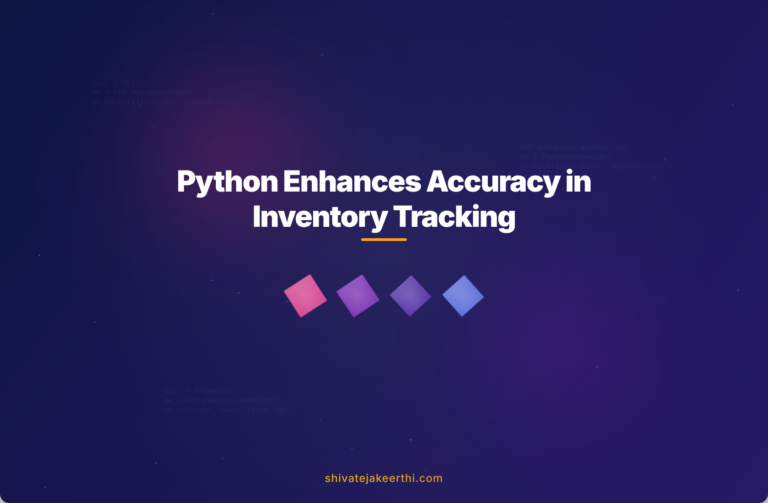When working with product inventory data from Excel, you’ve probably encountered cells with mixed content—product codes and quantities lumped together. Imagine opening an Excel file where a cell might contain “57892 x 400 units.” Clearly, 57892 is the product code and 400 is the quantity. But things are rarely that simple. Sometimes numbers overlap, formats shift, and suddenly the script mistakes a quantity for a product code.
Accurately distinguishing between product codes and quantities doesn’t just improve data integrity—it ensures proper inventory tracking, prevents costly mistakes in order fulfillment, and keeps reports trustworthy.
Thankfully, Python provides powerful tools to untangle these problems efficiently and reliably. Let’s examine the issue closely and see how a robust Python solution can help distinguish product codes from quantities embedded in mixed Excel cells.
Understanding the Challenge
Excel files are notorious for mixed or inconsistent data entry. Consider a situation where each Excel row corresponds to a different product, but the cell entry looks like this:
- “57892 – Qty: 400”
- “Qty 356 of product 67912”
- “Product no. 59321/245 units”
- “45738 x 150”
Because the format varies, basic scripts might mistakenly take quantities as product codes—especially if relying on something simple, like identifying 5-digit numbers. Unfortunately, there can be quantities which also consist of five digits, blurring the lines further.
The practical impact? Errors in inventory records, confusion during audits, and incorrect stock tracking. Clearly, a more reliable and sophisticated solution is needed.
Analyzing the Current Script for Data Extraction
Typically, reading Excel files in Python involves the widely-used pandas library—a powerful choice for analyzing spreadsheet data. Here’s a simplified version of a script you might currently use:
import pandas as pd
import re
# Load Excel file
df = pd.read_excel("products.xlsx", sheet_name="inventory")
def extract_product_codes(cell_value):
matches = re.findall(r'\b\d{5}\b', str(cell_value))
return matches[0] if matches else None
df['ProductCode'] = df['MixedColumn'].apply(extract_product_codes)
Here, the current logic simply grabs the first 5-digit number it encounters. If quantities or other irrelevant numbers appear first, accuracy decreases sharply.
So let’s ask ourselves: Is there an effective path forward?
Why This Simplistic Approach Fails
The root issue lies in the simplicity: treating every 5-digit number as a product code. This method overlooks the contextual clues that might clearly indicate whether a value represents a quantity or code.
Imagine a cell entry: “Shipped 250 units of product 67890.” Without deeper logic, 250 might be misidentified as the product code.
Improving Product Code Identification
We need more sophisticated logic—one based on context. To improve accuracy, approach extraction with careful string processing, regular expressions, and even text-pattern matching functions.
Let’s consider an enhanced Python snippet:
def extract_code_and_qty(cell_value):
text = str(cell_value).lower()
# Regex to find "Qty" followed by numbers
qty_match = re.search(r'(qty|quantity|units)[\s\:]*(\d+)', text)
quantity = int(qty_match.group(2)) if qty_match else None
# Regex to find "product" or common separators followed by 5-digit number
code_match = re.search(r'(?:product|prod|no\.?|#)?\s?[\:\-]?\s?(\b\d{5}\b)', text)
product_code = code_match.group(1) if code_match else None
return pd.Series([product_code, quantity])
df[['ProductCode', 'Quantity']] = df['MixedColumn'].apply(extract_code_and_qty)
This refined logic specifically searches for keywords (“product,” “qty”) ensuring accurate extraction of product codes and their associated quantities.
Best Considerations for Data Extraction
Precision in inventory management requires meticulous data extraction. Keep these vital considerations in mind:
- Consistent Formatting: Encourage clear and consistent data formats where possible.
- Contextual Clues: Leverage keywords like “units,” “product,” or “qty” to guide your extraction script.
- Data Validation: Always perform post-import data checks to ensure integrity.
- Regex Mastery: Familiarity with advanced regular expressions can greatly enhance your extraction logic. Need to brush up? Here’s a practical guide to Python with useful context.
Expert Recommendations
From industry best practices, experts suggest:
- Multi-step Parsing: Break down the extraction process into smaller, individually handled tasks—this minimizes false positives.
- Using Named Entity Recognition (NER): Tools like spaCy provide an advanced NER capability to identify and label numeric data intuitively.
- Cleaning with pandas: pandas’ built-in text processing functions help simplify redundant string operations efficiently.
Future Enhancements and More Powerful Solutions
As your extraction requirements evolve, consider incorporating machine learning to create automated data classifiers. Python frameworks like scikit-learn can be driven by previously extracted data samples to “learn” and accurately predict future entries.
For instance, training a classifier with thousands of labeled examples could vastly improve accuracy—saving you countless hours of tedious manual cleaning:
- Precision Automation: Build predictive models that differentiate between product codes and quantities with high accuracy.
- Continuous Improvement: Regularly retrain the model with new samples to improve long-term extraction power.
Take Your Excel Data Extraction to the Next Level
Clearly distinguishing product codes from quantities is crucial to accurate inventory analysis. The challenges posed by mixed Excel data cells are solvable with robust parsing methods in Python, focused on contextual clues and advanced number identification strategies.
Consider refining and continuously optimizing your script to ensure your data extraction remains highly reliable. Isn’t it time to adopt these practices and boost your inventory data accuracy?
What strategies are you considering next to improve your Excel parsing workflows? Have you thought about applying machine learning—why or why not? Share your experiences below, or reach out through our Python blog page for questions and ideas.



0 Comments